Reach maximum efficiency! Using a wood-fired pyrolysis boiler
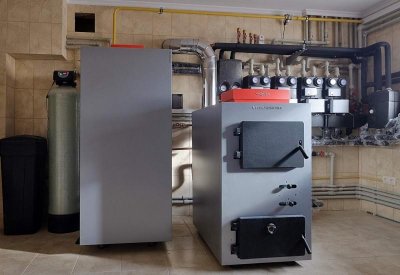
The principle of pyrolysis, implemented in heating boilers, is in obtaining heat from smoldering fuel at low oxygen content and the combustion of the gas formed as a result.
As a result, the burning time of the wood increases, and The equipment efficiency reaches 90%. In addition to wood-fired boilers, the market offers pyrolysis boilers that run on coal, coke and peat.
Structure and principle of operation
The basis of the heating boiler is a combustion chamber with two compartments, located inside a welded sheet steel housing.
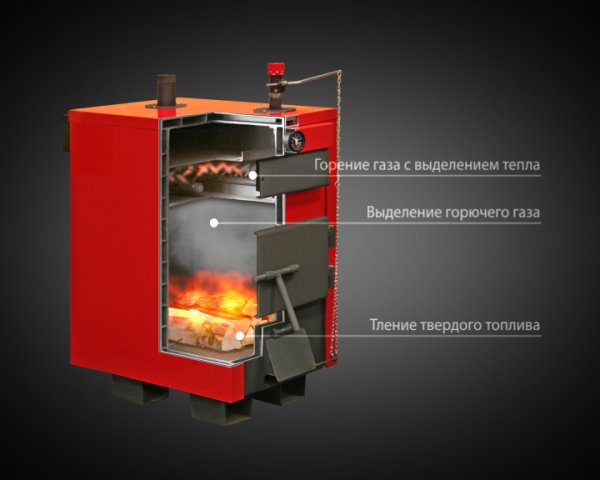
Photo 1. Internal structure of a wood-fired pyrolysis boiler. The arrows indicate the parts of the structure.
Combustion cycle in pyrolysis boilers is implemented as follows:
- After lighting the wood in the usual way, the damper closes;
- in the first chamber, an artificial oxygen deficiency is created, due to which the wood slowly smolders and emits smoke with a high particle content;
- smoke enters the second compartment through the nozzle, where, thanks to the additional supply of oxygen, the particles burn;
- part of the heat returns to the first compartment to maintain the smoldering temperature;
- Once the full cycle is completed, the residual gases are discharged through the chimney.
The process is ensured by the operation of components under automatic or manual control.: valves, fan or smoke exhauster, heat exchanger, water supply pipes and air supply channels.
With manual control To regulate the air supply to the compartments, dampers and chimney flaps are mainly used. With automatic — air is forced into the channels by a smoke exhauster or a fan. If the boiler is equipped with a moisture accumulator, water is supplied through pipes to the heat exchanger, where steam is formed, which serves to dilute the residual combustion products and prevent devices from overheating.
Important! For pyrolysis boilers, depending on the model protective mechanisms are provided: thermostatic air regulator, pressure sensor, safety valve and emergency release system for the working environment.
Types of wood pyrolysis boilers
Features of the functioning of a particular model Pyrolysis boilers are determined by the number of circuits, heat exchanger material, type of loading and the need for connection to the power grid - energy dependence.
- Single-circuit pyrolysis boilers provide heating only, dual-circuit — heating and hot water supply (DHW). The advantage of a single-circuit unit is high productivity and high power, but at the same time, DHW in the household is provided by other methods.
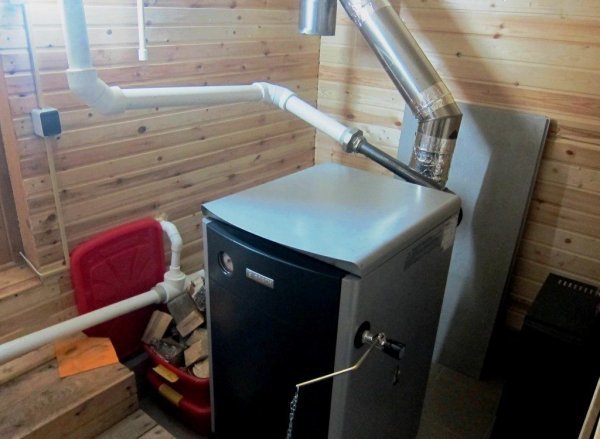
Photo 2. Wood pyrolysis boiler connected to the water heating circuit and chimney.
- The boiler heat exchanger is made of steel or cast iron. Steel ones are more common, as they are cheaper and weigh less, but boilers with a cast iron heat exchanger have better thermal characteristics and will last longer.
- The combustion chamber can be loaded from the top or bottom. Top loading is preferable, as it provides longer burning from one load and additional heating and drying of logs.
- Process automation Pyrolysis in boilers makes them energy-dependent and sensitive to voltage surges.
On the Russian market models of pyrolysis boilers of domestic and foreign manufacturers are presented. Their popularity is due to their unpretentiousness to the quality of fuel. Among them there are energy-independent ones, for example, without using electricity the boilers are working ZOTA.
Equipment from Germany presented by leaders Buderus, Viessmann and Bosch, from the Czech Republic — Atmos and Wattek, and the most popular in Russia - Stropuva. Boiler models Hargassner from Austria belong to the premium class - they are distinguished by full automation of the combustion process and the possibility of remote control. There are also models from Poland, but they did not become widespread.
Reference. An important point when choosing a pyrolysis boiler is the presence of an extensive dealer network from the manufacturer and availability of components.
The lining of wood pyrolysis boilers is unique in its configuration and can only be purchased from the manufacturer. For example, nozzle - ceramic nozzle between the boiler chambers - withstands thermal shocks with an amplitude of almost 600ºС and wears out over time 3-4 years during the service life of the case 15-20 years.
Fuel
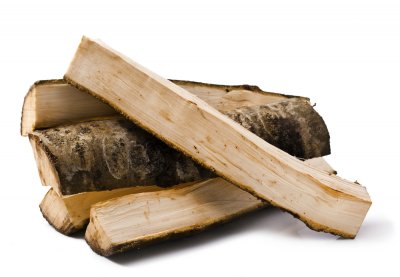
Boilers operate at maximum efficiency only if The firewood meets the following requirements:
- Conifers are contraindicated grades due to high resin content, which can lead to equipment failure.
- Hardwood firewood is suitable - alder, oak, acacia, beech.
- In devices with a bottom tab humidity fuel is allowed no more than 20%, from the top - 45%.
- Pyrolysis boilers designed for firewood, It is forbidden to burn coal or wood waste.
Important! Accurate fuel moisture readings are measured with an electric moisture meter, the principle of which is based on changing the electrical conductivity of the material.
Preparation and storage of firewood
If we compare direct and pyrolysis combustion boilers, the fuel consumption of the latter 5 times lower.
Reference. Per day for heating 100 m2 required 11 kg wood, and the consumption depends on the moisture content of the wood. During the heating season, the average consumption in a private house is 6-10 m3.
The warehouse area is calculated based on the following considerations:
- To ensure that the logs dry to the recommended temperatures 20% humidity, they must be aged for two heating seasons.
- Firewood harvested this year, can only be used after a year, i.e. the storage area is calculated on triple volume one season.
Attention! Storing firewood in the boiler room is prohibited, the warehouse must be equipped in a separate, possibly adjacent room.
Installation and operation
When choosing a location for installing the device, the following should be taken into account:
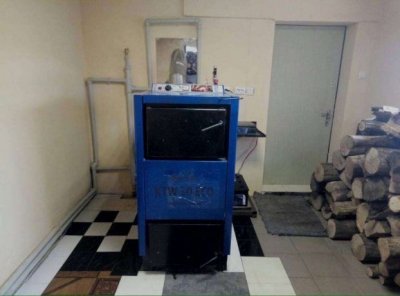
- Durability of floors — the weight of the units is measured in hundreds of kilograms.
- Energy-dependent models will require power supply, in case of power outages, operation will be greatly hampered; connection via an IVS is necessary.
Installation, connection and commissioning of pyrolysis boilers are carried out by services that have a certificate of admission to work, affecting the safety of residential properties.
An employee of such a service must conduct training on the rules for operating the boiler and make a corresponding entry in the warranty card, otherwise it is considered invalid.
Firebox
The process of kindling and adding firewood depends on the design of a particular boiler. In general terms, it includes kindling, the main operating mode, and its completion.
- Before starting the kindling check the amount of water in the heating system And connect the shut-off valves.
- When starting the fire, open the damper and kindling wood chips on a piece of paper. Small firewood is placed on the resulting fire. After it catches fire, approximately 1/3 of the firewood, through 5-7 minutes fill the firebox completely and close the damper.
- Efficient heating is the main operating mode. When the fuel will burn 9/10 from a full load, you can wait for complete combustion by slightly opening the air supply adjustment door, or add fuel. If you add less than half of the full load of firewood, then there is no need to regulate the further process. Otherwise, you will need to ensure an air flow so that smoke comes from the firewood.
- Completion of the firebox. Once the fire has stopped, there will be ash-like coals that need to be removed. at least once every 10 days or when their level becomes higher than the top of the air supply adjustment door.
Cleaning the device
Regular cleaning is required to maintain the unit in working order. When using high-quality fuel, it is sufficient one cleaning per month, with low quality - once every 2-3 weeks. Unscheduled cleaning is carried out when operating indicators deteriorate.
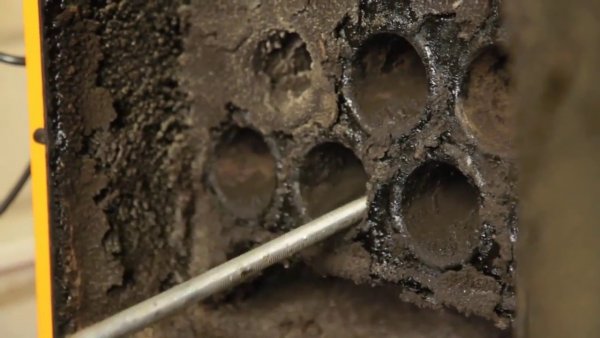
Photo 3. Cleaning a wood-fired heating boiler from combustion products. This is done using a special brush.
You can clean the boiler manually - brushes and scrapers using chalk and soda ash, as well as steam generator.
Useful video
Watch the video, which talks about the pros and cons of pyrolysis heating boilers.
Advantages and disadvantages of wood pyrolysis boilers
Unlike direct combustion devices, pyrolysis boilers are more environmentally friendly and economical, since they Efficiency with proper operation reaches 90%, A fuel consumption is 5 times lower. The disadvantages include the higher cost, as well as a larger warehouse area for storing firewood.







Comments